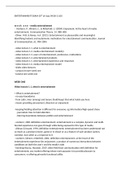ENTERTAINMENT EXAM 30th of may 09:00-11:00
w e e k o n e - media entertainment
- Vorderer, P., Klimmt, C., & Ritterfeld, U. (2004). Enjoyment: At the heart of media
entertainment. Communication Theory, 14, 388–408.
- Oliver, M.B. & Raney, A.A. (2011). Entertainment as pleasurable and meaningful:
Identifying hedonic and eudaimonic motivations for entertainment communication. Journal
of Communication, 61, 984-1004.
- video lecture 1.1, what is entertainment
- video lecture 1.2, media entertainment model(s)
- video lecture 1.3, users of entertainment, preference, motivations
- video lecture 1.4, entertainment products
- video lecture 1.5, entertainment experience and responses
- video lecture 1.6, media entertainment model
- slides video lectures
- campus lecture week one
- tutorial one week one
WEEK ONE
Video lecture 1.1, what is entertainment
> What is entertainment?
- no easy boundaries
- from Latin, inter (among) and tenere (hold/keep) that what holds you here
- means providing amusement, diversion or enjoyment
- keeping/holding attention is different for everyone, eg information/high-speed chase
- journalism tries to hold attention
- blurring boundaries between politics and entertainment
- vorderer, 2001 definition entertainment; entertainment is a complex, dynamic and multi-
faceted experience one goes through while being exposed to this type of media
- zillman & bryant, 1994, definition entertainment; entertainment has been understood not
so much as a product (movie, game or tv show) or as a feature of such product (action,
comedy), but rather as a response to it
- vorderer, klimmt, retterfeld, 2004, definition entertainment; at the heart of the
entertainment experience lies enjoyment, a product of numerous interactions between
conditions on both the user’s and the media’s side
- henning-thurau, Houston, 2019, other field than communication with definition for
entertainment; any market offering whose main purpose is to provide pleasure to
consumers, vs offering primarily functional utility
,- boring = not entertaining, but who decides what is boring?
- the attributes of experience dominate consumers quality judgement
- when does something start/stop to be entertaining? where is the line drawn?
conclusion, entertainment is: any mediated product for the purpose of entertainment
Video lecture 1.2, media entertainment model
Inspired from:
> Laswell’s linear model of communication 1948, process
+ includes the right questions
- no room audiences to choose a
message
- how is the effect achieved?
> Valkenburg & Peter, model of DSMM, different susceptibility to media effects model, 2013
- not aimed at
entertainment
= development use,
only children/adults
- three factors predict media use: preference, development, social environment
- media effects are transnational, meaning effects of media use also influence media use
> Vordereer, Klimmt & Ritterfeld, enjoyment at heart of entertainment, 2004
- enjoyment not only
outcome
- messy and confusing
+ acknowledges
complexity
+ represents circular
process
,> media entertainment model
- boxes =
theoretical
- arrows =
processes
- entertainment products: label and design
- users: preference and performance
- circular process, infancy, start using and experiencing media and entertainment, over time
knowledge/attitudes beliefs are formed
- you select media based on the medium, title, genre, brand (label)
- design, is how to
- you then experience it
- you respond, did you like it or not?
- what you like gets a preference
- which makes you decide/select the next thing
- response is not an effect, unless it affects your entertainment preference in a meaningful
way
Video lecture 1.3, users of entertainment + preference + motivations
> You as a person
- traits, characteristics, what you like (as part of a group)
- 4 overlapping identifiable characteristics to categorize groups of entertainment users, they
shape the preference
1. Demographic
- gender, age, income, education, location, ethnicity
2. Social
- culture, family, friends, peers, society
3. Trait and state
- psychological traits, cognitive capabilities, attitudes/values/beliefs, state, mood
4. Media entertainment
, - experience, knowledge
> popular culture
; most prevalent set of preferences within society
; popular culture (pop culture) is the domain of entertainment products created in mass
quantities for a mass audience, generally recognized as a constantly evolving set of practices,
beliefs, values that are dominant or ubiquitous in a society at a given point in time
- Deshpande & Webster, 1989,
- group culture provides you in the norms and attitudes for behaviour
> definition; set of practices/beliefs and values around entertainment that is dominant in a
society at any point in time
- current entertainment culture, constantly evolving
- created in mass quantities for enormous audience
- influential, economically and culturally, globally
> cultural congruence
‘’a nation transmits the values of what is to be appreciated and what is not, to its members,
as a part of continuous and often lifelong socialization process’’
- schäfer and sedlmeiser, 2009, say: consumers entertainment choices show their personal
values, ambitions and beliefs, and perceptions of the world and themselves
- song et al, 2018, say: cultural congruence between a movie and audience influences how
much consumers like the product.
> preference, zeitgeist
- cultural trends can make consumers ripe for a product. The fit of any entertainments
product genres and themes with people’s interests and desires may be high or low during
certain periods
- entertainment can become an embodiment of a certain cultural zeitgeist, capturing and
reflecting the lifestyle of a certain period.
- entertainment products are more attractive in bleaker economic times, despite consumers
having less money at their disposal.
> why people select entertainment
- escapism; tendency to seek distraction and relief from unpleasant realities, especially by
seeking entertainment or engaging in fantasy’, --> transiel mental relief
- mood management theory; use of entertainment serves the regulation of positive mood
states
- individuals tend to select entertainment in order to maximize or maintain a good mood,
and/or diminish or alleviate a bad mood
- music consumption, tv viewing patterns, and movie patterns
- only for light-hearted entertainment





